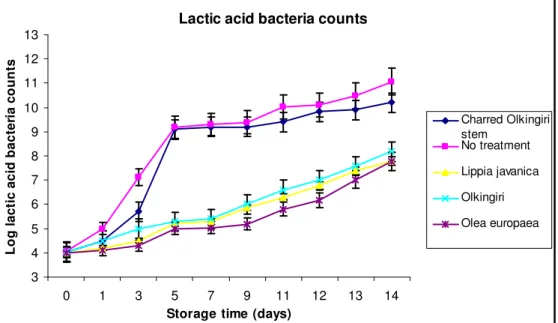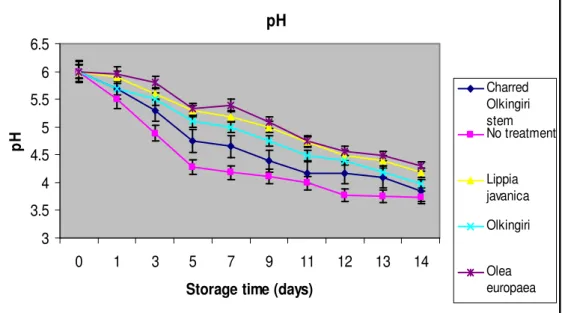5935
Preservative effect of various indigenous plants on
fermented milk from Maasai community of Kajiado
County
1Onyango C. A, 2Gakuya L. W, 5Mathooko F. M, 2Maina J. M, 2Nyaberi M. O, 3Makobe M, 4Mwaura, F.
1Taita Taveta University College, P. O. Box 635 – 80300, Voi, Kenya
2Department of Food Science and Technology of Jomo Kenyatta University of Agriculture and Technology, P. O. Box 62000-00200 Nairobi Kenya:
3Department of Botany Jomo Kenyatta University of Agriculture and Technology;
4School of Human Resource Development Jomo Kenyatta University of Agriculture and Technology: 5South Eastern University College, P. O. Box 170-90200 Kitui;
Corresponding author email: cakoth2000@yahoo.co.uk
Original submitted in on 12th July 2013 Published online at www.m.elewa.org on 31st January 2014.
ABSTRACT
Objective: This study was conducted to verify the claim that incorporation of indigenous plants in milk extends the shelf life of fresh milk for four days, and that of fermented milk for up to one a month without spoilage.
Methodology and results: In this study, three indigenous plants namely Lippia javanica, Olkingiri and Olea europaea used by the Maasai community in Kajiado district to process and preserve milk were collected from the field. An aqueous extract concentration of 40mg/ml was prepared from each of the plants and introduced into each milk sample with a control that did not have the extract. Between the third day and the 14th day the fermented milk was analyzed every second day for aerobic plate count using method 966.23 (AOAC. 1995), titratable acidity using method 947.05 (AOAC, 1995) and pH changes. Aerobic plate counts increased constantly in all the samples, the highest was the control with counts of 10.00 – 11.40 log cfu/ml and the lowest was milk with Olea europaea with counts of 5.05 – 8.38 log cfu/ml. The control exhibited the highest titratable acidity of 1.08 - 1.87% while that treated with Olea europaea had 0.41 – 0.98%. Fermented milk without treatment had the lowest pH of between 4.18 – 3.73 while the highest pH was exhibited by fermented milk with Olea europaea of between 5.33-4.29.
Conclusion and application: Fermented milk treated with plant extracts had better quality properties than fermented milk without any treatment; therefore, the Maasai community in Kajiado County is justified to use these herbs to process and preserve milk. This practice should be made available for commercial use. Keywords: Indigenous plants, fermentation
INTRODUCTION
The use of traditional plants is of tremendous importance in many societies, including most rural African communities (Bussmann et al., 2006). Apart from providing building materials, fodder, weapons and other commodities, plants are
especially important as traditional medicines (Sidigia et al., 1990). According to a study on utilization of indigenous plants by the Maasai community, plant life is very important to Maasai community (Maundu et al., 2001). They are mainly
Journal of Applied Biosciences 73:5935– 5941
5936 used as foods, building and construction material, fuel, human and veterinary medicine and fodder. Plants also find important uses in ceremonies and rituals as well as for brushing teeth and chewing to pass time and exercise the jaws. In the Maasai community in Kajiado district, milk is usually fermented immediately rather than consumed fresh (Suttie, 2001). Another reason why milk may be consumed fermented would be lactose intolerance that is very common in Africans (Frederick et al,. 2010) Raw milk is filled into a traditionally treated gourd made from the hollowed out dried fruit of the plant Lagenaria siceraria. The dried calabash, used as fermentation gourd is gently rubbed with a burning end of a chopped stick from the tree Olea africana locally known as Enkidogoe allowing charcoal to break inside (Mathara, 1999). This procedure is repeated at least three times. The gourd is filled with milk and then closed by a special cap obtained from the same gourd during its preparation. After fermentation, the product is gently shaken before consumption.
Plate 1: Fermentation gourd with smoking end of Olea africana used for preparation before milk is poured into the gourd. (Photo by C. A. Onyango 2010)
METHODOLOGY
Preparation of plant extracts: Plant material: The information on the type of herbs used and the way preservation of milk was undertaken, was obtained by personal observation and focused discussions guided by a questionnaire. Three groups of respondents were involved, elders, women and youth groups. From each
group fifteen respondents were interviewed. All the respondents were from Kajiado County. The three plants commonly used in milk processing and preservation Lippia javanica, Olkingiri and Olea europaea (Table 1) were identified, collected and cleaned using running water.
Table 1: Plants collected from the Central division; Kajiado Sub County Local
name
Botanical name family plant
type
part used
Local Use Osinon Lippia javanica (Burm.
F.) Spreng
Verbenaceae* Shrub stem Applied to milk gourd before milk fermentation
Olorien Olea europea ssp.africana (Mill)
Oleaceae- Tree root Applied to milk gourd before milk fermentation
Olkingiri Pending identification Pending identification
Shrub stem Applied to milk gourd before milk fermentation
* Nairobi National Museum of Kenya + (Kokwaro, 1993) - (Maundu, et al., 2001) ~ (Kiringe, 2006) The samples were chopped into small pieces and dried
at ambient temperatures of 25 ± 2 °C in a room for six days. The samples were ground into moderately coarse powder using an electric grinder (model M10R Japan) and stored until use. The samples were then ashed and sequentially extracted with distilled water (1:5) at room temperatures according to Trease and Evans method
(Trease and Evans, 1987). The aqueous extracts were used for this study.
Preparation of fermented milk samples: Fresh milk was collected from Kajiado County in Kenya. And transported to the Jomo Kenyatta University of Agriculture and Technology Food Engineering Laboratory were the fresh milk was pasteurized at 80
5937
°C for 1 min to eliminate background flora. Five 500ml batches of fermented milk were prepared from the pasteurized milk in gourds. One batch was prepared using the Olkingiri stem were the charred plant stem was applied on the inside wall of the gourd then fresh milk was introduced. In each of the other three batches, an extract from the three plants Lippia javanica,
Olkingiri and Olea europaea was introduced at a concentration of 1:500. The concentration of the aqueous extracts was 40 mg/ml obtained by diluting 40 mg of the water extract in 1ml distilled water. The last batch was the control. The five milk samples were left to ferment naturally at ambient temperature of 25±2°C for three days as illustrated in Figure 1.
Fresh milk
Pasteurization (80 °C 1 min)
Cool to 25 °C
Fermentation for 3 days
Analyses (27±2°C) Figure 1: Flow diagram for preparation of fermented milk samples After fermentation, the milk samples were stored at
ambient temperatures for 11 days and the following parameters were determined; pH, titratable acidity and changes in microbial quality.
Test for Quality Properties of the Fermented milk: The aerobic plate count technique method 966.23 (AOAC, 1995) was used to determine total plate count using nutrient agar. Man, Rogosa and Sharpes (MRS)
agar was used in anaerobic conditions to obtain lactic acid bacteria counts. The microbial counts to compare the quality properties of the five fermented milk samples were carried out daily for 11 days.
Titratable acidity of fermented milk Samples: The percentage titratable acidity was determined according to AOAC method 947.05 (AOAC, 1995). To 20 ml of milk sample, 40 ml of boiled and cooleddistilled water
Lippia javanica water
extract Olkingiri water extract No treatment Olea europaea water extract Charred Olkingiri stem
5938
was added, and 2 ml of phenolphthalein (prepared at 1% in 95% ethanol). The mixture was titrated with standardized0.1M Sodium hydroxide until the first color change (to pink) persistedfor 30s, one more drop of 0.1M Sodium hydroxide was added and the final volume noted. The percentage titratable acidity was thereafter calculated.
pH determination: A small aliquot of 10 ml of each plant aqueous extract was taken and 10 ml of each fermented milk samples was placed in the measurement cell of a compact pH meter (Horiba B-212) and pH was read out. All determinations were carried out in triplicate.
RESULTS AND DISCUSSION
Total plate counts : Total plate counts increased constantly in all the milk samples up to the 14th day. However, there was a significant difference between the fermented milk samples without any treatment with plate counts of 10.00 – 11.40 log cfu/ml and the three
herbs Lippia javanica, Olkingiri and Olea european. The fermented milk treated with Olea europaea had the lowest total plate counts of 5.05 - 8.38 log cfu/ml at P<0.05 level of significance.
Total plate counts
3 4 5 6 7 8 9 10 11 12 13 0 1 3 5 7 9 11 12 13 14
Storage time (days)
L o g t o ta l p la te c o u n ts Charred Olkingiri stem No treatment Lippia javanica Olkingiri Olea europaea
Figure 2: Total plate counts of fermented milk samples containing different plant preparations and stored at room temperature (27±2°C)
In this study, the total plate counts for the fermented milk treated with plant extracts fell within the expected range in cultured milk, which is 106 – 109 (Mathara et al., 1995). However, the total plate counts for the fermented milk without any treatment increased to 1011 on the 11th day.
Lactic acid bacteria counts: The LAB counts increased continuously in all the samples, as shown in Figure 3. This trend is similar to that of lactic acid bacteria (LAB) growth as cited in microbiological quality of fermented milk produced by repeated batch culture (Nakasaki et al., 1998). There was a significant difference in lactic acid bacteria (LAB) counts within the five fermented milk samples prepared with different
treatments in 11 days at P<0.05 level of significance. The control had the highest LAB counts of 9.20 -11.06 log cfu/ml in all the days in comparison to the fermented milk samples while the fermented milk with the Olea europaea water extracts had the lowest LAB counts of 5.00 - 7.78 log cfu/ml. This might have been attributed to the phytochemicals in the aqueous plant extracts that might have had an influence on the growth and multiplication of LAB. At a level of significance P<0.05, the fermented milk with Lippia javanica 5.29 – 8.19 log cfu/ml had higher LAB than the fermented milk with Olea europaea 5.00 – 7.78 log cfu/ml and Olkingiri 5.2 – 7.79 log cfu/ml. There was a significant difference of the LAB counts between the fermented milk with
5939
charred Olkingiri stem and the fermented milk with the aqueous extracts. The fermented milk with charred Olkingiri stem had LAB counts of 9.10 - 10.20 log cfu/ml in comparison to the fermented milk with the water extract of Olkingiri stem which had LAB counts of 5.39 - 8.19 log cfu/ml at P<0.05 level of significance. The direct application of the charred Olkingiri stem on the
milk gourd might have caused less interaction of the phytochemicals in the charred materials and the fermented milk in comparison to the interaction of the phytochemicals in the water extracts with the fermented milk. This reduced interaction might have contributed to less inhibition of LAB in fermented milk with charred Olkingiri stem thus less LAB counts.
Lactic acid bacteria counts
3 4 5 6 7 8 9 10 11 12 13 0 1 3 5 7 9 11 12 13 14
Storage time (days)
L o g l a c ti c a c id b a c te ri a c o u n ts Charred Olkingiri stem No treatment Lippia javanica Olkingiri Olea europaea
Figure 3: Lactic acid bacteria (LAB) counts of fermented milk containing different plant preparations and stored at room temperature (27±2°C)
Titratable acidity: There was continuous increase in titratable acidity in all the samples. Titratable acidity in fermented milk without any treatment increased to 1.87% as shown in Figure 4. The control had the highest titratable acidity of 1.08-1.87 %throughout the study period in comparison to the fermented milk samples under the other condition. The high titratable acidity may have contributed to high total plate counts, which predominantly may have been acid producing bacteria. The fermented milk with the plant extracts had the lower titratable acidity of between 0.41-0.98 % in
comparison to the other fermented milk samples under the other conditions. This might be attributed to the phytochemicals in the water plant extracts that might have had an influence on the proliferation of acid producing bacteria thus low titratable acidity. The fermented milk with Olkingiri 0.78 – 1.4% had higher titratable acidity than the fermented milk with Olea europaea 0.41 – 0.98% and Lippia javanica 0.49 – 1.08%. This may be attributed to the high LAB counts in this milk sample, which may have led to high production of lactic acid.
5940 % Titratable acidity 0 0.2 0.4 0.6 0.8 1 1.2 1.4 1.6 1.8 2 0 1 3 5 7 9 11 12 13 14
Storage time (days)
% T it ra ta b le a c id it y Charred Olkingiri stem No treatment Lippia javanica Olkingiri Olea europaea
Figure 4: Titratable acidity of fermented milk containing different plant preparations and stored at room temperature (27±2°C)
pH of the fermented milk : There was significant difference in pH in the five fermented milk samples stored with different treatments for 14days as indicated in Figure 5. The pH decreased continuously up to the 14th day. This might have been attributed to continuous increase in titratable acidity that might have continuously lowered the pH. This is according to the general pathway for fermentation of milk, which involves the production of lactic acid from lactose in the milk. This lowers the pH and results in a variety of products. During milk fermentation, the pH usually
drops to 4.3-4.5. It was observed that the fermented milk without any treatment had the lowest pH of 4.18-3.73 all the days in comparison to all other milk samples. The fermented milk with the Olea europaea had the highest pH of 5.33-4.29 in comparison to the other fermented milk samples with other treatments at a level of significance of P<0.05. This may be attributed to the phytochemicals in the plant extracts, which may have lowered the proliferation of microorganisms thus reduced production of acid.
pH 3 3.5 4 4.5 5 5.5 6 6.5 0 1 3 5 7 9 11 12 13 14
Storage time (days)
p H Charred Olkingiri stem No treatment Lippia javanica Olkingiri Olea europaea
5941
This study showed that the fermented milk with the three plants water extracts had gradual changes in all properties in comparison to the fermented milk without treatment. This may be an indication that the fermented milk with plant extracts may keep longer than the fermented milk sample without treatment. The Maasai claim that the fermented milk can be stored and be taken even after 30 days. However, from the results above it is evident that by that time the milk would be
beyond the palatable stage. This claim can however be accepted on the fact that fresh milk is added continuously, most of the times daily, to the fermented milk therefore making it palatable even at that stage because of reduced pH. The phytochemical constituents of these plants should be studied because this could be the source of the differences in the quality properties.
ACKNOWLEDGEMENT
The authors acknowledge Jomo Kenyatta University of Agriculture and Technology for funding the project. REFERENCES
AOAC. 1995. Official methods of analysis of AOAC International 15th Edition. Methods 923.03, 925.23, 947.05 & 966.23. Washington D.C. Bussmann R. W., Gilbreath G. G., Solio J, Lutura M,
Lutuluo R., Kunguru K., Wood N., and Mathenge S. G. 2006. Plant use of the Maasai of Sekenani Valley, Maasai Mara, Kenya. J Ethnobiol. Ethnomed. 2: 22.
Frederick J. S; Patsy M. ; Thomas O. C.; Jose R. F., Vicente G.; Jeffrey B. G.; Karen .; Siu L. H.; Joanne L.; Julie M.; Natalie J. M.;Stavroula K. O.; Deborah E. S.; and Marshall A. W. 2010 Lactose Intolerance and Health. NIH Conference, Annals of Internal Medicine Volume 152; 12
Mathara J. M. Miyamoto T., Koaze H., Kiiyukia C., and Yoneya T. 1995. Production of Traditional Fermented Milk in Kenya (a Review). 257-263 Mathara J. M. 1999. Studies on Lactic acid producing
microflora in Mursik and Kule naoto, traditional fermented milks from Nandi and Maasai communities in Kenya. Msc. Thesis. University of Nairobi, Kenya.
Maundu P., Berger D. J., ole Saitabau C., Nasieku J., Kipelian M., Mathenge S. G., Morimoto Y., Höft R. 2001.Ethnobotany of the Loita Maasai:
Towards Community Management of the Forest of the Lost Child - Experiences from the Loita Ethnobotany Project. People and Plants working paper 8.UNESCO, Paris.
Nakasaki K., Yanagisawa M. and Kobayashi K. 2008. Microbiological quality of fermented milk produced by repeated batch culture. J. Biosc. and Bioeng. 5(1):73-76
Sidigia, I., Nyaigotti-Chacha, C., Kanunah, M. P. 1990. Traditional Medicine in Africa. East African Educational Publishers, Nairobi;
Suttie J. M. 2001. Livestock as food for pastoralists in Africa
http://www.taa.org.uk/TAAScotland/Livestocka sfoodforpastoralistsinAfrica2001.htm
Trease G. E. and Evans W. C. 1987. Pharmacognsy. 12th edn. Brailliar Tiridel Can. Macmillan Publishers
Kiringe J. W. 2006. A survey of traditional health remedies used by the Maasai of Southern Kajiado district, Kenya. Ethnobotany Research and applications 4: 061-037.
Kokwaro J. O. 1993. Medicinal plants of East Africa. East Africa Publishers. Nairobi, Kenya.
http://scidiv.bcc.ctc.edu/rkr/Biology201 /lectures/Respiration/ Respiration.html).



